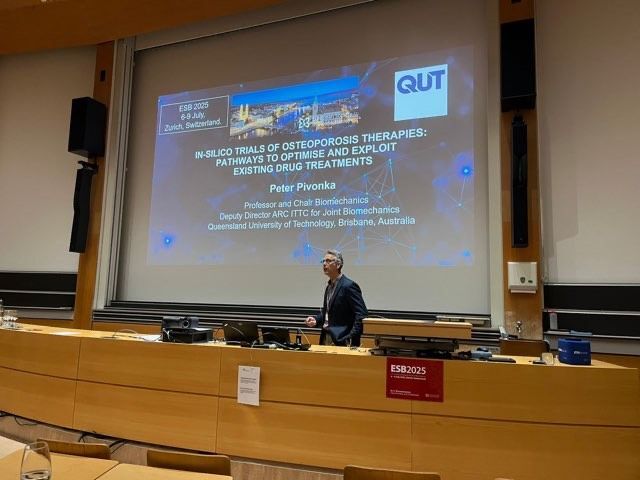
At the recent European Society of Biomechanics (ESB) Congress held at ETH Zurich, leaders in biomedical technology gathered to explore how artificial intelligence is reshaping the future of healthcare. Among the perspective talks was a fascinating presentation by Professor Peter Pivonka, Deputy Centre Director of the ARC Training Centre for Joint Biomechanics.
Prof Pivonka’s talk “In-Silico Trials Of Osteoporosis Therapies: Pathways To Optimise And Exploit Existing Drug Treatments” detailed emerging approaches called in-silico trials. These are computer simulations that mimic how bones change over time and how treatments behave inside the body. These trials offer doctors and researchers a way to “test” therapies virtually before applying them in the real world.
This method could have a real impact on how osteoporosis is diagnosed and treated. Traditionally, medications like denosumab have been prescribed based on broad age-related guidelines. But Prof Pivonka’s research shows that timing matters far more than we thought, especially for women entering menopause.
His team found that if denosumab is given too early, for example before the age of 60 or within 10 years of menopause, its efficacy may be challenged. That insight could help refine treatment plans and avoid unnecessary costs or side effects from poorly timed therapies.
For clinicians, these virtual trials offer a glimpse into a future where treatment isn’t one-size-fits-all. Instead, healthcare providers could use simulation data to tailor osteoporosis therapies based on each patient’s unique biology, age, and health history.
By simulating how bones degrade and rebuild, and analysing the molecular factors that drive those changes, this research helps distinguish between different types of osteoporosis—like postmenopausal versus age-related. That distinction is crucial, as it guides doctors towards more precise prescriptions and better patient outcomes.
Prof Pivonka’s work goes beyond the lab. It’s part of a bigger movement to bring advanced computing and biomedical engineering directly into hospitals and clinics. With AI-driven models and virtual testing, researchers can identify which existing medications work best, fast-track clinical decisions, and reduce the need for large, time-consuming trials.
This has real impact not just for specialists, but for GPs, pharmacists, and health systems navigating a growing, ageing population at risk of fractures and mobility issues.
As biomechanics enters the AI era, Prof Pivonka’s presentation signals a shift in how medicine approaches bone health. More than just new science, it’s a new mindset: data-driven, patient-specific, and digitally powered.


